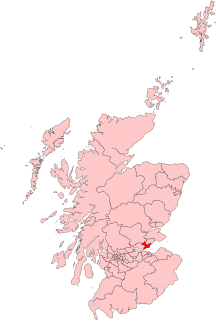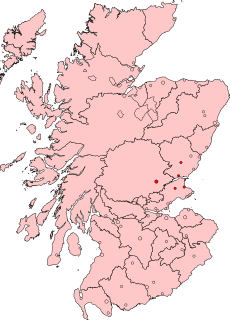Related Research Articles

Kirkcaldy and Cowdenbeath is a county constituency representing the areas around the towns of Kirkcaldy and Cowdenbeath, in Fife, Scotland, in the House of Commons of the Parliament of the United Kingdom. It is currently represented by Alba Party politician Neale Hanvey.

Kirkcaldy was a county constituency of the House of Commons of the Parliament of the United Kingdom in Fife, returning one Member of Parliament (MP). It existed from the February 1974 election until its abolition in 2005.
Inverness Burghs was a district of burghs constituency of the House of Commons of the Parliament of Great Britain from 1708 to 1801 and of the Parliament of the United Kingdom from 1801 to 1918. It elected one Member of Parliament (MP).
Inverness-shire was a county constituency of the House of Commons of the Parliament of Great Britain from 1708 to 1801 and of the Parliament of the United Kingdom from 1801 until 1918.
The Act of Union 1707 and pre-Union Scottish legislation provided for 14 Members of Parliament (MPs) from Scotland to be elected from districts of burghs. All the parliamentary burghs were assigned to a district, except for Edinburgh which had an MP to itself. The burghs in a district were not necessarily adjacent or even close together.
Tain Burghs, was a constituency of the House of Commons of the Parliament of Great Britain from 1708 to 1801 and of the Parliament of the United Kingdom from 1801 to 1832, sometimes known as Northern Burghs. It was represented by one Member of Parliament (MP).
Wigtown Burghs, also known as Wigton Burghs,. was a constituency of the House of Commons of the Parliament of Great Britain from 1708 to 1800 and of the House of Commons of the Parliament of the United Kingdom from 1801 to 1885. It was represented by one Member of Parliament (MP).

Perth Burghs was a district of burghs constituency of the House of Commons of the Parliament of Great Britain from 1708 to 1801 and of the Parliament of the United Kingdom from 1801 until 1832, representing a seat for one Member of Parliament (MP)
Kirkcaldy Burghs was a burgh constituency of the House of Commons of the Parliament of the United Kingdom (Westminster) from 1832 to 1974. It elected one Member of Parliament (MP) by the first-past-the-post voting system. From 1832 to 1950 it was, officially, a district of burghs constituency.

James Townsend Oswald was a Scottish politician who sat in the House of Commons between 1768 and 1779.

James Oswald was a Scottish politician who sat in the House of Commons from 1741 to 1768.
Sir James Abercrombie, 1st Baronet, of Edinburgh, was a British Army officer and Scottish Whig politician who sat in the House of Commons of Great Britain in 1710.

Sir Ronald Craufurd Ferguson, was a Scottish officer in the British Army and a Member of Parliament for the constituencies of Dysart Burghs and for Nottingham.

Robert Ferguson of Raith, was at various times a Whig Member of Parliament for Fifeshire, Haddingtonshire and Kirkcaldy Burghs, and at the time of his death he was Lord Lieutenant of the county of Fife.

John Johnstone was a Scottish nabob, a corrupt official of the British East India Company who returned home with great wealth. Described as "a shrewd and unscrupulous business man", he survived several scandals and became a major landowner when he returned to Scotland in 1765.
Sir William Johnstone, 2nd Baronet of Sciennes and Westerhall was a Scottish landowner and politician who sat in the Parliament of Scotland from 1698 to 1707 and in the British House of Commons between 1707 and 1722.
Burntisland in Fife was a royal burgh that returned one commissioner to the Parliament of Scotland and to the Convention of Estates.
Kinghorn in Fife was a royal burgh that returned one commissioner to the Parliament of Scotland and to the Convention of Estates.
Kirkcaldy in Fife was a royal burgh that returned one commissioner to the Parliament of Scotland and to the Convention of Estates. It was represented in Parliament from at least 1571 until 1707.

James Oswald was a member of the Parliament of Scotland, 1703-1707, representing Kirkcaldy and, later, the member for Dysart Burghs in the House of Commons of Great Britain.
References
- The Parliaments of England by Henry Stooks Smith (1st edition published in three volumes 1844–50), 2nd edition edited (in one volume) by F.W.S. Craig (Political Reference Publications 1973)
- House of Commons 1754–1790, by Sir Lewis Namier and John Brooke (Secker and Warburg 1964)
- ↑ "Dumfries Burghs". History of Parliament Online (1690-1715). Retrieved 27 March 2019.
- ↑ "Dumfries Burghs". History of Parliament Online (1715-1754). Retrieved 27 March 2019.
- ↑ "Dumfries Burghs". History of Parliament Online (1754-1790). Retrieved 27 March 2019.
- ↑ "Dumfries Burghs". History of Parliament Online (1790-1820). Retrieved 27 March 2019.
- ↑ "Dumfries Burghs". History of Parliament Online (1820-1832). Retrieved 27 March 2019.
- ↑ Leigh Rayment's Historical List of MPs – Constituencies beginning with "D" (part 4)